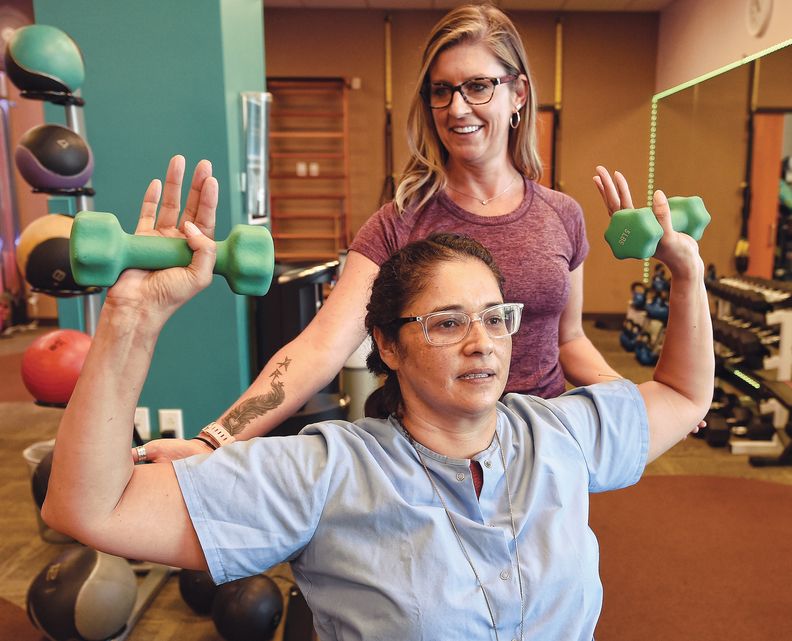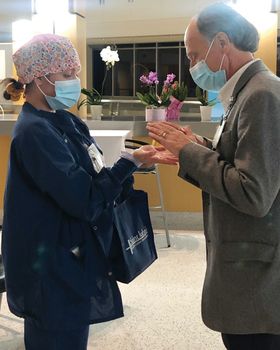
Sanford Health started coordinating virtual meetings in April 2020 for its medical staff, who shared how they were coping with the COVID-19 pandemic. The psychologist-led discussions aimed to be informal outlets for clinicians to learn from each other, as well as how the Sioux Falls, South Dakota.-based health system could take better care of its front-line staff. Hopefully, they recognized that it was OK to not be OK, said Dr. Luis Garcia, president of Sanford’s clinic division. “One of the realities of mental health inside and outside of medicine is we don’t talk much about it,” he said, adding that many are worried about the repercussions of sharing that they are depressed. “But in the midst of an extremely difficult situation—people dying and the uncertainty of the disease—there were moments of bonding, strengthening and recognition.” Those meetings, town-hall events and one-on-one conversations shaped a more comprehensive strategy around Sanford’s identification and prevention of mental health issues, Garcia said. The health system, for instance, has invested more in its wellness council, where physicians and advanced practice practitioners meet monthly to relay how its employees are feeling and how the organization can adapt. “The stigma is real,” said Karoliina Slack, senior director of operations for Sanford World Clinics. “The willingness to ask for those resources is one of the barriers we have been working hard to break down.” Health systems often respond to trauma with initiatives to improve communication across their workforce. But it’s difficult to justify the return on investment on these programs, which can limit their longevity and impact. Healthcare leaders say that the pandemic has more than justified the sustained investment in employee wellness programs, but only time will tell. Health system executives are hopeful that the pandemic will have a permanent impact on how they interact with employees. COVID-19 has made an indelible mark on healthcare employees, personally and professionally, and health systems need to adapt accordingly, experts said. “These initiatives are typically seen as an expense rather than an investment,” Garcia said. “This can’t just be a one-and-done conversation—we need a consistent and comprehensive engagement strategy that applies to not just physicians, but all employees.” The pandemic resurfaced long-standing issues in healthcare. Prior to COVID-19, about two in five critical-care nurses reported symptoms of depression while about half said they were anxious, according to a study of nearly 800 nurses from mid-2018 to mid-2019 by the Ohio State University College of Nursing. That was linked to an increase in self-reported medical errors. “We know a burned-out physician has a statistically higher risk of adverse outcomes related to medical errors,” said Garcia, adding that Sanford is comparing employee satisfaction data to patient satisfaction and outcomes. The pandemic exacerbated those symptoms across all healthcare employees, and permanently impacted staffing models and day-to-day operations. “This is a year of healing and renewal for our workforce,” said Greg Till, chief people officer at Providence, adding that the Renton, Washington-based system has tripled its in investment in employee well-being resources. “That’s not going to stop in 2021. There is a real sense of PTSD, and the loss felt among the workforce is incredible.”SLASH AND BURN That sense of loss deepens as many healthcare organizations laid people off, cut hours and pay or reduced benefits during the pandemic. More than 60% of healthcare organizations furloughed staff and 43% suspended or postponed retirement plan contributions last year, according to NEPC’s recent survey of 51 companies.
 PROVIDENCE
PROVIDENCE
Providence St. Joseph Hospital wellness coordinator Kristyna Maurin, background, and Patty Huizar, a scheduler in electrocardiology, work out in the hospital’s caregiver gym. Caregivers receive free personal training sessions and access to in-person and virtual exercise classes, including yoga, body sculpting and high-intensity interval training.
“We can’t have swings of slashing and burning the workforce and maintain commitment and loyalty,” Till said. “Healthcare unemployment is around 2%, there’s a staffing crisis and attrition is increasing. We need to invest in our workplace infrastructure more than ever.” Burnout and affiliated issues such as inadequate supply chain inventory, are taking on a broader importance within the C-suite and boardrooms, said Lauren Rewers, a research consultant at Optum’s Advisory Board. “A focus on workforce is shared more broadly among the C-suite,” she said. “There will be a reluctance in decreasing labor costs because there is a realization, especially as staffing is short, of the need to retain the current workforce if you want to advance strategic initiatives.” At one recent health system board meeting, seven out of 10 topics were about the workforce, said Liz Bickley, senior client partner at staffing firm Korn Ferry. “That wasn’t the case 18 months ago,” she said, adding that hiring is a huge priority, along with engagement and burnout. “Healthcare workers probably have more options than ever right now. Organizations that are more thoughtful around individually tailored reward packages are going to win in the war for talent.”
 PROVIDENCE
PROVIDENCE
Paul Makarewicz, chief mission integration officer at Providence St. John’s, blesses the hands of caregivers during Hospital Week, an annual ritual of gratitude for the work they do to heal patients.
Providence maintained full salaries for clinical staff the first several months of the pandemic, which cost around $600 million, Till said. The system also offered unlimited childcare reimbursement, an array of virtual mental health services and closely incorporated front-line workers into the decision-making process, Till added. For instance, Providence leaders worked closely with their clinical staff to design remote working models across the system, he said. Providence is looking at the staffing mix rather than staffing reduction. It is ensuring that clinicians are practicing at the top of their license and using gig workers, advanced practice practitioners and predictive scheduling tools to fill in any holes, he said. “AI will be worldview-changing over the next 10 years, especially for healthcare,” Till said. “Data and automation will help us deliver better outcomes and allow us to provide personalized benefits, engagement tactics and retention strategy for every caregiver.” Organizations that were once an all-registered-nurse environment are using licensed practical nurses or medical assistants in a team-based nursing model, said Erin Shipley, a coach at consultancy Huron, who is also a licensed RN. “That’s a workforce they can tap into, and naturally there is a shift in dollars,” she said. Replacing an RN can cost around $65,000; if an organization has 12% RN turnover, that can add up, Shipley said. Organizations are beginning to break down first-year versus third-year turnover and what that means for their operations, she said. “Most front-line leaders haven’t been trained in understanding what turnover means for the department,” Shipley said. “Organizations could get a lot of lift by innovating their onboarding.”
REMOTE MONITORING Providers are also using digital tools to keep in touch with their increasingly mobile workforce as more administrative employees are working from home than ever before. Telehealth has afforded a similar luxury for some clinicians. Rather than losing an employee, managers are more willing to give them more flexible schedules, change departments or bump up pay, said Neil Faux, a managing director at consultancy Berkeley Resource Group. “There is a lot of hesitation to reinstitute pre-pandemic productivity expectations, which could increase turnover,” he said, noting that it’s taking longer to fill positions as certain types of staff run short, which has increased job openings by 20% to 30% at many healthcare organizations. “They are moving people around instead.” Still, healthcare workers are leaving the workforce, both young and old. Senior employees fast-tracked their retirement plans while younger workers are opting for less-stressful careers. Westmoreland Manor, a long-term care facility in Greensburg, Pennsylvania, has tried to keep employees invested during the pandemic by offering lotteries, free meals, counseling sessions and other perks, said Nancy McCune, healthcare system administrator at Westmoreland. “Management is more open to listening to employees and changing things to make their lives’ easier,” she said, adding that Westmoreland has changed reporting structures, offered them iPads and adjusted its time-off request process to ease workers’ burden. “That has made a big difference.” Employers are more cognizant of employees who are working extra hours, and proactively checking in on them. Some providers have eliminated prerequisites for certain jobs, like education requirements, prioritizing cultural fit. The knee-jerk reaction to staffing shortages is to double down on recruiting. But executives should rethink their value proposition so they can hang on to top talent, Rewers said. “Executives need to make sure they are not overlooking their current workforce,” she said. If healthcare providers don’t create internal opportunities to advance, employees will find other options, Faux said. “If they do leave and want to return, they will likely be welcomed back. So there is not a lot of risk,” he said.
LISTEN UP Whether it’s informal check-ins or wellness town halls, providers are expected to continue the dialogue. Some health systems have created a diversity forum that allow employees to discuss social and racial unrest, said Neville Bilimoria, partner at law firm Duane Morris. “Doing that on a regular basis throughout the pandemic went a long way and staff reported that attendance at these meetings by leadership was powerful, demonstrating a caring and concerted understanding by the employer of important issues the employees were facing on a daily basis,” Bilimoria said. Many managers huddled with their teams multiple times a day during the pandemic to discuss the latest regulations, supply chain management or workloads. Proactive organizations will continue that daily practice, albeit less frequently, so employees feel heard, Shipley said. Those check-ins could reveal that an employee wants to go to grad school or switch departments, which could help carve out workforce development programs and boost retention, she said. “Employees need to feel that they are informed,” Shipley said. “That conversation is centered around trust.”
 PROVIDENCE
PROVIDENCE
Caregivers at Providence St. John’s Health Center in Santa Monica, Calif., welcomed the complementary haircuts and manicures provided by the Beauty Bus team.
Healthcare executives are worried about breaching that trust if they force their staff to get vaccinated. While some have made official decrees, most are tiptoeing around the issue as they balance workplace safety with employee preferences. Houston Methodist, for instance, suspended more than 170 of its employees who refused to get vaccinated, which spurred a lawsuit. “Employers will continue to struggle with that,” Faux said. Outside of the pandemic, change rarely comes quickly in healthcare. But managers and executives need to recognize and honor the fundamental shift in employer-employee discourse. Employees are human first, employees second, Faux said. “It’s about being human first,” he said. “Beyond the public outcry of people recognizing healthcare workers as heroes, they are asking employers to put their money where their mouth is—‘show me you mean it with higher pay, flexibility, career pathways.’ ”
Source link : https://www.modernhealthcare.com/people/healthcare-workers-are-humans-first-employees-second











